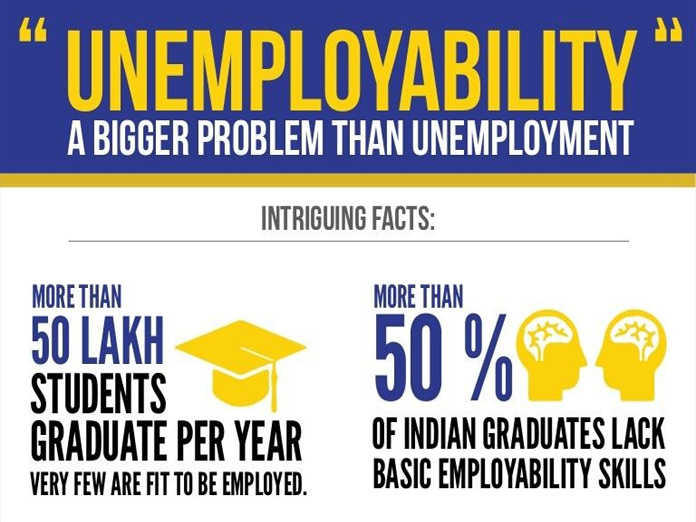Live
- Anushka Sharma unleashes her ‘wild side’
- Pawan Kalyan Meets PM Modi Discusses on Jaljeevan Mission Funds
- SMAT 2024: Urvil Patel smashes fastest T20 ton by an Indian batter, breaks Pant's record
- New AC rake adds 13 more ‘cool’ train services on Mumbai suburban section
- Malaika Arora is living her best life on a moving train
- IPL: Is Venkatesh Iyer KKR’s Next Captain?
- Dalit youth beaten to death in MP's Shivpuri, four arrested
- UN welcomes Israel-Lebanon ceasefire agreement
- Yuvana’s Mesmerising Kuchipudi Debut
- Shiv Sena's Kayande slams LoP Gandhi over Savarkar comments
Just In

Unemployment today has grown to become a major area of concern on a global level Despite increasing number of educational institutions, growing volumes of academic courses, and booming industries, unemployment in India seems to be on a constant rise
Unemployment today has grown to become a major area of concern on a global level. Despite increasing number of educational institutions, growing volumes of academic courses, and booming industries, unemployment in India seems to be on a constant rise.
In a country like India, inspite of there being is a cultural focus on academic learning and professional qualification, a wide disconnect between education and acquiring skills can be observed. The Gross Enrolment Ratio (GRE) for Indian higher education has been just 34% which is very low in comparison to developed countries that have a GRE of 56%.
In spite of this, close to 60 lakh students graduate every year in several disciplines. Very few of them are deemed fit for employment. Over 70% of these graduates lack basic employable skills and quality. It is estimated that 10 lakh people will join the labour force every month for the coming 20 years and most of them have inadequate training. This may lead to many layoffs.
In a volatile and ever-evolving environment like that of the IT industry, mere formal educational qualifications are not enough. It is necessary to have the relevant IT skills which are allied to the dynamic changes in IT as an industry as well as job roles. Recruiters today, also prefer candidates with high learnability, adaptability and scalability. The lack of these qualities is becoming a strategic concern.
It is emerging more clearly than ever before that what needs to be fixed is unemployability. Unemployability is the illness and unemployment is merely a symptom thereof. The illness needs to be treated and not the symptom.
The skills mismatch is a stark reality staring into the eyes of graduates. There are millions of graduates hoping to start working, but soon realise that the employers are looking for skills that they never even got.
This is when young people end up experiencing the bitter and sometimes almost impossible campus-to-corporate transition. While it is indisputably hard on the students’ side, it is also hard for organizations to find suitable candidates for their many positions. There is a severe shortage of progressive institutions that provide updated, quality, industry-oriented higher education due to lack of awareness and absence of industry orientation.
While India is now shrugging off its ‘developing’ country image, majority of the education sector largely lacks the technology and infrastructure needed for hands-on training in the digital sector. This is when the youth are at a disadvantage in the job market by the lack of skills in terms of application.
The solution
While basic graduation and technical education can be seen as an entry point, students need to invest in employable skills in relevant technologies with specific learning paths. These learning paths should ultimately set the learners on a career path.
The IT landscape is constantly changing and it is the need of the hour for prospective and existing workforce to continuously upgrade their skills in order to contribute to the growth of the organisation, industries, society and the economy. It is time for individuals, institutions and enterprises to come together and engage with relevant platforms to address this issue. The panacea would be in embracing a holistic approach to learning and architecting relevant training methodologies and curricula that align with the industry requirements and job demands.
The current learning ecosystem needs to thoughtfully consider how to architect learning programmes that can be further customised to meet learning objectives while also supporting different learning styles in holistic environments with an outcome-based approach. By responding to the niche expectations of the 21st century students, and eliminating restrictions regarding what constitutes as a learning space, we need to go beyond the confines of traditional methods. It is the need of the hour that we become facilitators and enablers of an enhanced learning process.
The largely adopted brick-and-mortar approach to learning that dates back to early 18th Century has remained virtually unchanged - until now. The rise of new pedagogies (such as Blended Learning) has been dominating today's educational and learning reforms. Despite the challenges, lack of understanding and a steep learning curve, embracing blended learning is increasingly less of an option and more of a mandate.
Learning as a concept needs to change. It needs to happen beyond the limitations of time and space. It becomes an immersive and engaging indulgence with a series of rich experiences on the pathway to get more employable, and a result fight unemployment. Multiple approaches are needed to solve a problem as large as this. But we need to remember, what needs to be fixed is unemployability, then unemployment will fix itself.
(Keshava Raju - The author is CEO and Founder, Indian Institute of Hardware Technology)

© 2024 Hyderabad Media House Limited/The Hans India. All rights reserved. Powered by hocalwire.com







